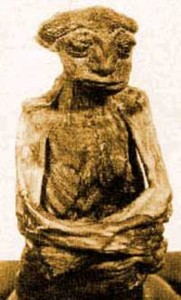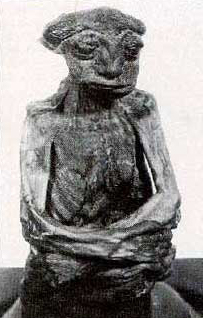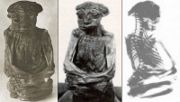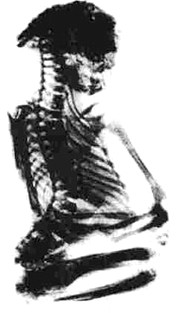Pedro Mountain Mummy and the Mysterious Dr. George Gill
Posted by: Loren Coleman on November 9th, 2010

The story of the Little People and the Pedro Mountain Mummy is a near classic in Fortean literature. To see it resurface again, in the following well-written piece, is rather amazing.
Of course, within the archives of Bigfoot-related articles and expert opinion transcripts, perhaps as mysterious is the figure of a shadowy anthropologist named George Gill. He pops up in the following two recent treatments.
In the early years of paperback books about Sasquatch mysteries, now and then, Gill’s name would be found sprinkled in random paragraphs, giving his insights, oh so briefly, on a recent sightings or a supposed behavior pattern. Some of us felt George Gill was a mythical creature, almost as elusive as the alleged little mummy itself, and that he had been a device invented by the likes of writers named Eric Norman, who only existed as a pen name among a forest of paperback pseudonyms. Now here Dr. Gill is again.
So, is George Gill for real? And what does this supposed historical figure in Bigfoot consultations have to say about the Pedro Mountain Mummy?

The Little People fabled to live in the Wind River Range are good, as long as you don’t make them mad.
Eastern Shoshone elder Morning Starr Moses Weed knows what happens if you cross them.
As the story goes, his father-in-law rode up a thin trail into the Wind River mountains many years ago to check on his cattle. One of the Little People appeared, standing no more than knee high, though otherwise looking like a normal human. He told Weed’s father-in-law that it was his trail, and the rancher couldn’t use it anymore. But Shoshone rancher had cows up the hill. He went ahead anyway.
The Little Person shot Weed’s father-in-law with a poisonous arrow, making his arm useless.
But they’re not all bad, Weed says. He knows other stories in which the Little People save lives or help Shoshones find their way back home.
The Shoshones aren’t the only people to describe a race of Little People. For centuries, other American Indians have had variations of their own.
George Gill, a forensic anthropologist, speculates that white settlers to the Wind River area believed the stories to simply be myths.
Until the mummies were found.
In 1936, Eugene Bashor saw the mummy for the first time. It was in a circus tent in Casper, a brochure claiming it was the remains of a 65-year-old man, weighing less than a pound.
He saw that it looked like an old person: big nose, wide mouth, high brows and a head proportional to the body. It didn’t look like a child.
Bashor saw it again in 1948. The used car dealer who owned it had it sitting on his desk. That was before a New York con-man swindled the mummy away from the dealer, and before the dealer died a mysterious death and the mummy disappeared.
Bashor, a power plant operator on Seminoe Dam, spent the next half-century looking for information on the Pedro Mountain Mummy. He’d wander the Pedros, looking in caves for signs of other mummies.
He advertised nationwide for leads.
He has a pair of tiny mummified feet found near Buffalo. Analysis on those showed they were from an infant.
Through the years, Bashor heard stories of the Pedro Mountain Mummy turning up in Florida with the New York con man, but none of them materialized. The tiny mummy, and the man, had simply vanished.
In 1971, the University of Wyoming hired its only physical anthropologist, George Gill. Because of his background in studying human remains, students immediately told Gill about the Pedro Mountain Mummy.
During his first week teaching, they brought him brochures of the mummy. Was it a human? Was it from a race of knee-high people? They wanted to know.
By then, the mummy had vanished. All that remained were X-rays, pictures and mummified feet.
As more people investigated the mummies and the Little People, others came forward with mummy-like creatures. Gill has a perfect likeness of one of the mummies in the university’s human remains repository. The man who bought it paid big money for the treasure, a mummified head of a little person.
Unfortunately, analysis at the Wyoming state crime lab showed the man paid big money for what turned out to be a well carved potato head.
Then in 1994, both Gill and Bashor went on Unsolved Mysteries. Host Robert Stack explained the vague details of the mummy and asked for help from the public. Gill explained that the mummy may not have been an adult. It was a human, he believed, and X-rays and a lung analysis done by Harry Shapiro at the American Museum of Natural History in New York City, showed that the mummy was an infant, with a disease called anencephaly.
A Cheyenne family watching the Unsolved Mysteries episode produced a family heirloom found by a great-grandfather. It was a girl, slightly smaller, with the same striking features.
Analysis concluded the tiny mummy was human, but she was most likely a premature baby.
Anencephaly, while rare, happens occasionally, usually a combination of genetics and diet. Cases appeared in Ireland during the potato famine, and Gill speculates the Pedro Mountain mummy as well as the girl may have been part of a group of people new to the area and unfamiliar with the diet here.
Carbon dating put her age around 300 years old, not tens of thousands, as the circus brochures initially claimed.
The family took its mummy back to Cheyenne and has since moved. Gill doesn’t know where.
While the testing proves the mummy was neither ancient nor an adult, Gill still wonders why it was preserved in such a sacred way.
All of the mysteries behind the two mummies, and how they could link to American Indian stories, may never be discovered.
Only three known anencephalic mummies exist in the world – two from central Wyoming, one from ancient Egypt.
Bashor, 84, no longer believes in a race of little people and just wants information on that mummy he saw so many years ago. He worries it may be gone, thrown away or lost in someone’s boxes.
Gill believes there’s much to be learned about the mystery of the mummies, the legends that preceded them, and the possibility of some connection.
Weed simply said there are too many stories, with too many details, for them not to be real.
“They’re good little fellows,” he said. “If you don’t make them mad.”

As fate would have it, Dr. George Gill received a micro-profile in October 2010, in conjunction with a recent investigation. Perhaps Gill is a real man, after all.
Skeleton discovered in ghost town, reappears in Kemmerer
Posted: Friday, Oct 29th, 2010
BY: Kay Murphy Fatheree, Gazette reporterSounds like Kemmerer has some skeletons in its closet!
Lincoln County Coroner, Mike Richins, reports to the Gazette that there has been a literal skeleton recently discovered in the evidence locker of the Lincoln County Sheriff’s office. An officer was cleaning out the evidence locker and made the discovery.
The skeleton was unidentified and Richins has been conducting an investigation for over a year to try to identify the remains.
“It is nearly an entire skeleton, about 85 percent of a skeletal remains, and is in really good condition,” Richins said. “Some people who were looking for artifacts and antiques found it (the skeleton) in 1979. They uncovered the remains and dug it up. They left the site and eventually reported it to the sheriff’s office, but they had ruined the scene. It was investigated at the time and (the skeleton) was placed in the evidence locker because they ran into a ‘dead end,’ not to make a pun or anything, and the case went cold.”
The case was reopened last year following the skeleton’s re-appearance and Richins is searching for records of dentists who were in the area in the 1910s and 1920s. “There were lots of dentists who came and left this area,” Richins said. “Some of them took their dental records with them, which makes identification very difficult. “
The skeleton legally belongs to the coroner, but has been sent to Laramie for study with Dr. George Gill a retired anthropologist with the University of Wyoming.
“Dr. Gill is the foremost world expert on native American and western forensic anthropology,” Richins said. “In fact, he is the foremost expert on skeletal remains in North America and Central America. He is the world’s best.”
Dr. Gill was able to determine the skeleton’s approximate height, age, race and gender.
The victim is a male, between the ages of 33 and 43, but most likely about 36 according to Gill’s research. He was about 5′ 9″ in height, and was “Caucasian.”
“It is looking a lot like he might be a miner who went missing at that time, in the early 1920s,” Richins said. “He was a German immigrant who came over here in 1902. He was from a town called Laufen, Germany, on the German/Austrian border.”
His name was Frank Skorjanz. In 1908, he changed his last name to “Lark” and eventually settled in Cumberland, Wyoming.
“Things were pretty loose back then,” Richins explained. “If you stumbled on a still, you could get shot.”
“We discovered that he had an altercation with another fellow,” Richins said. He turned up missing on a ‘cold wintry night’ some time between 1922 and 1924 according to the testimony of an eyewitness from Sublette.
“This man wasn’t buried,” Richins said. “He was found in an old underground structure that had been used to hold ice in the ice cream parlor in the ghost town of Sublette. He could very well have fallen in and could not get out and froze to death or died of exposure. The skeleton is not showing signs of major trauma or gunshot or knife markings.”
For reasons unknown, in the 1920s, the county sheriff removed all the possessions from Lark’s house in Cumberland and burned the house down.
The dental work done on the skull is unique, and may help identify the dentist, which could help lead to a positive identification of the victim. The mouth is also missing a couple of teeth, which Richins believes may have been removed from the skull or lost when it was originally discovered.
“One other thing that is really unique is that he had an extra lumbar vertebrae,” Richins said.
If Richins can locate a photo of Skorjanz/Lark, he could create a reconstruction of the skull and compare the two to help identify the remains. “The skull that I have is very good, very well preserved,” Richins said. “I can do a good reconstruction. It would give more credence to my being able to go to Germany and search for family there.”
He is also searching for old mining photos and any family members in the U.S. and in Germany in addition to looking for former dentists in the area from 1915 through 1925 and dental records from the same period.
Anyone with information about this case, the whereabouts of anyone in the Skorjanz or Lark family or dentists from the specified era is asked to contact Richins at (307) 886-9048.
“If we can put this fellow to rest that would be wonderful,” Richins said.
For the complete article see the 10-28-2010 issue.

It appears George W. Gill is a real anthropologist. Above, from the Nova site, is Dr. George Gill (and Jaime Stuart). See a Gill-authored item here.
His mini-bio tells us the man has lived a rather standardized career in forensic anthropology: “Dr. George W. Gill is a professor of anthropology at the University of Wyoming. He also serves as the forensic anthropologist for Wyoming law-enforcement agencies and the Wyoming State Crime Laboratory.”
Nevertheless, in terms of early quotations about Bigfoot/Sasquatch, good researchers will find Gill’s name as frequently as they will discover Grover Krantz’s, in old dusty paperbacks from the 1970s, long before Krantz published his first book.
About Loren Coleman
Loren Coleman is one of the world’s leading cryptozoologists, some say “the” leading living cryptozoologist. Certainly, he is acknowledged as the current living American researcher and writer who has most popularized cryptozoology in the late 20th and early 21st centuries.
Starting his fieldwork and investigations in 1960, after traveling and trekking extensively in pursuit of cryptozoological mysteries, Coleman began writing to share his experiences in 1969. An honorary member of Ivan T. Sanderson’s Society for the Investigation of the Unexplained in the 1970s, Coleman has been bestowed with similar honorary memberships of the North Idaho College Cryptozoology Club in 1983, and in subsequent years, that of the British Columbia Scientific Cryptozoology Club, CryptoSafari International, and other international organizations. He was also a Life Member and Benefactor of the International Society of Cryptozoology (now-defunct).
Loren Coleman’s daily blog, as a member of the Cryptomundo Team, served as an ongoing avenue of communication for the ever-growing body of cryptozoo news from 2005 through 2013. He returned as an infrequent contributor beginning Halloween week of 2015.
Coleman is the founder in 2003, and current director of the International Cryptozoology Museum in Portland, Maine.











I’ve met Dr. Gill, he lives…seems to be a nice guy.
The illustrious Dr. Gill IS real–that I can verify as I studied under him at the University of Wyoming shortly before he retired. He is truly one of the best scientists in the country–a veritable gold-mine of information! It’s too bad he’s no longer teaching–the anthropology department lost a great instructor when he left.